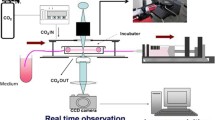Abstract
A clear understanding on cell migration behaviors contributes to designing novel biomaterials in tissue engineering and elucidating related tissue regeneration processes. Many traditional evaluation methods on cell migration including scratch assay and transwell migration assay possess all kinds of limitations. In this study, a novel honeycomb cell assay kit was designed and made of photosensitive resin by 3D printing. This kit has seven hexagonal culture chambers so that it can evaluate the horizontal cell migration behavior in response to six surrounding environments simultaneously, eliminating the effect of gravity on cells. Here this cell assay kit was successfully applied to evaluate endothelial cell migration cultured on self-assembling peptide (SAP) RADA (AcN-RADARADARADARADA-CONH2) nanofiber hydrogel toward different functionalized SAP hydrogels. Our results indicated that the functionalized RADA hydrogels with different concentration of bioactive motifs of KLT or PRG could induce cell migration in a dose-dependent manner. The total number and migration distance of endothelial cells on functionalized SAP hydrogels significantly increased with increasing concentration of bioactive motif PRG or KLT. Therefore, the honeycomb cell assay kit provides a simple, efficient and convenient tool to investigate cell migration behavior in response to multi-environments simultaneously.
Similar content being viewed by others
References
Lauffenburger D A, Horwitz A F. Cell migration: a physically integrated molecular process. Cell, 1996, 84(3): 359–369
Reig G, Pulgar E, ConchaML. Cell migration: from tissue culture to embryos. Development, 2014, 141(10): 1999–2013
Van Nieuwenhuysen T, Vleminckx K. Cell migration during development. eLS, 2014, doi: 10.1002/9780470015902. a0020864.pub2
Shaw T J, Martin P. Wound repair at a glance. Journal of Cell Science, 2009, 122(18): 3209–3213
Gurtner G C, Werner S, Barrandon Y, et al. Wound repair and regeneration. Nature, 2008, 453(7193): 314–321
Yamaguchi H, Wyckoff J, Condeelis J. Cell migration in tumors. Current Opinion in Cell Biology, 2005, 17(5): 559–564
Hollister S J. Porous scaffold design for tissue engineering. Nature Materials, 2005, 4(7): 518–524
Griffith L G, Naughton G. Tissue engineering — current challenges and expanding opportunities. Science, 2002, 295 (5557): 1009–1014
Petrie R J, Doyle A D, Yamada K M. Random versus directionally persistent cell migration. Nature Reviews: Molecular Cell Biology, 2009, 10(8): 538–549
Pankov R, Endo Y, Even-Ram S, et al. A Rac switch regulates random versus directionally persistent cell migration. The Journal of Cell Biology, 2005, 170(5): 793–802
Haeger A, Wolf K, Zegers M M, et al. Collective cell migration: guidance principles and hierarchies. Trends in Cell Biology, 2015, 25(9): 556–566
Rørth P. Whence directionality: guidance mechanisms in solitary and collective cell migration. Developmental Cell, 2011, 20(1): 9–18
Lutolf M P, Hubbell J A. Synthetic biomaterials as instructive extracellular microenvironments for morphogenesis in tissue engineering. Nature Biotechnology, 2005, 23(1): 47–55
Kramer N, Walzl A, Unger C, et al. In vitro cell migration and invasion assays. Mutation Research/Reviews in Mutation Research, 2013, 752(1): 10–24
Hulkower K I, Herber R L. Cell migration and invasion assays as tools for drug discovery. Pharmaceutics, 2011, 3(1): 107–124
Lei K F, Tseng H P, Lee C Y, et al. Quantitative study of cell invasion process under extracellular stimulation of cytokine in a microfluidic device. Scientific Reports, 2016, 6: 25557
Meng Q, Yao S, Wang X, et al. RADA16: A self-assembly peptide hydrogel for the application in tissue regeneration. Journal of Biomaterials and Tissue Engineering, 2014, 4(12): 1019–1029
Liu X, Wang X, Wang X, et al. Functionalized self-assembling peptide nanofiber hydrogels mimic stem cell niche to control human adipose stem cell behavior in vitro. Acta Biomaterialia, 2013, 9(6): 6798–6805
Wang X, Qiao L, Horii A. Screening of functionalized selfassembling peptide nanofiber scaffolds with angiogenic activity for endothelial cell growth. Progress in Natural Science: Materials International, 2011, 21(2): 111–116
Wang X, Horii A, Zhang S. Designer functionalized selfassembling peptide nanofiber scaffolds for growth, migration, and tubulogenesis of human umbilical vein endothelial cells. Soft Matter, 2008, 4(12): 2388–2395
Liu X, Wang X, Horii A, et al. In vivo studies on angiogenic activity of two designer self-assembling peptide scaffold hydrogels in the chicken embryo chorioallantoic membrane. Nanoscale, 2012, 4(8): 2720–2727
D’Andrea L D, Iaccarino G, Fattorusso R, et al. Targeting angiogenesis: structural characterization and biological properties of a de novo engineered VEGF mimicking peptide. Proceedings of the National Academy of Sciences of the United States of America, 2005, 102(40): 14215–14220
Kouvroukoglou S, Dee K C, Bizios R, et al. Endothelial cell migration on surfaces modified with immobilized adhesive peptides. Biomaterials, 2000, 21(17): 1725–1733
Aguzzi M S, Giampietri C, De Marchis F, et al. RGDS peptide induces caspase 8 and caspase 9 activation in human endothelial cells. Blood, 2004, 103(11): 4180–4187
Form D M, Pratt B M, Madri J A. Endothelial cell proliferation during angiogenesis. In vitro modulation by basement membrane components. Laboratory Investigation, 1986, 55(5): 521–530
Acknowledgements
This research was supported by the National Natural Science Foundation of China (Grant Nos. 51572144 and 21371106) and the Tsinghua University Initiative Scientific Research Program (Grant No. 20161080091).
Author information
Authors and Affiliations
Corresponding author
Additional information
F.G. and J.L. contributed equally to this paper.
Rights and permissions
About this article
Cite this article
Guan, F., Lu, J. & Wang, X. A novel honeycomb cell assay kit designed for evaluating horizontal cell migration in response to functionalized self-assembling peptide hydrogels. Front. Mater. Sci. 11, 13–21 (2017). https://doi.org/10.1007/s11706-017-0369-9
Received:
Accepted:
Published:
Issue Date:
DOI: https://doi.org/10.1007/s11706-017-0369-9



